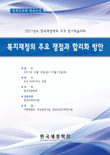- 영문명
- 발행기관
- 한국재정학회(구 한국재정·공공경제학회)
- 저자명
- Keigo KAMEDA
- 간행물 정보
- 『한국재정학회 학술대회 논문집』2011년도 추계학술대회 논문집, 1~23쪽, 전체 23쪽
- 주제분류
- 경제경영 > 경제학
- 파일형태
- 발행일자
- 2011.10.30

국문 초록
영문 초록
In the past two decades, the Japanese government has spent a considerable amount of money to counteract the deep recessions that have recurred since 1992. Many studies have pointed out that the effects of these expenditures have diminished since around the 1990s. None of these studies, however, have statistically tested the reasons for this diminution, which they implicitly or explicitly mention. The purpose of this study is to statistically test these reasons, using a threshold VAR in which the causes pointed out in the literature are adopted as the threshold. If the null hypothesis that the estimated parameters are equal under each regime is rejected, we can say that a given cause does affect the structure of the macro economy, and then the effects of fiscal policy. We then estimate the impulse response functions in both sample periods as constructed based upon the threshold estimates, and compare the effects of fiscal policy in each period.
The results of the study are as follows. First, we found that the diffusion index of the attitude of financial institutions toward lending and the yearly change in the annual average of the quarterly structural-primary-budget-balance-to-potential-GDP ratio rejects the null hypothesis to a significant degree; therefore, we considered that these variables have a definite impact upon the effects of fiscal expansion. Second, the resulting impulse response functions show that the effects are basically traditional, though there are some notable differences. In particular, a crowding-in of private investment is the result of banks’ relaxed attitude toward lending and the sound financial condition of the government. Finally, in bad times, the demand-enhancing effects of public investment should be considered to be weak. In this regard, non-interest rate channels of the crowding-out of private investment, excess accumulation of public capital, and non-Keynesian effects are the key operative concepts.
목차
Abstract
1. Introduction
2. Statistical Methodology and Data
3. Impulse Response Functions under Each Regime
4. Concluding Remarks
Data Appendix
References
키워드
해당간행물 수록 논문
참고문헌
최근 이용한 논문
교보eBook 첫 방문을 환영 합니다!

신규가입 혜택 지급이 완료 되었습니다.
바로 사용 가능한 교보e캐시 1,000원 (유효기간 7일)
지금 바로 교보eBook의 다양한 콘텐츠를 이용해 보세요!


